| |
Therapeutic Management of Nonhospitalized Adults With COVID-19
|
| |
| |
Last Updated: April 1, 2022
https://www.covid19treatmentguidelines.nih.gov/management/clinical-management/nonhospitalized-adults--therapeutic-management/
Several therapeutic options are now available for the treatment of nonhospitalized adults with mild to moderate COVID-19 who are at high risk of disease progression. A number of factors may affect the selection of the best treatment option for a specific patient. These factors include the clinical efficacy and availability of the treatment option, the feasibility of administering parenteral medications (i.e., remdesivir), the potential for significant drug-drug interactions (e.g., those associated with the use of ritonavir-boosted nirmatrelvir [Paxlovid]), and the regional prevalence of variants of concern (VOC) (e.g., the prevalence of the BA.2 subvariant of the Omicron VOC, which may affect the activity of sotrovimab).
Figure 1 outlines the COVID-19 Treatment Guidelines Panel's (the Panel) recommendations for using these therapeutic interventions outside the hospital inpatient setting.
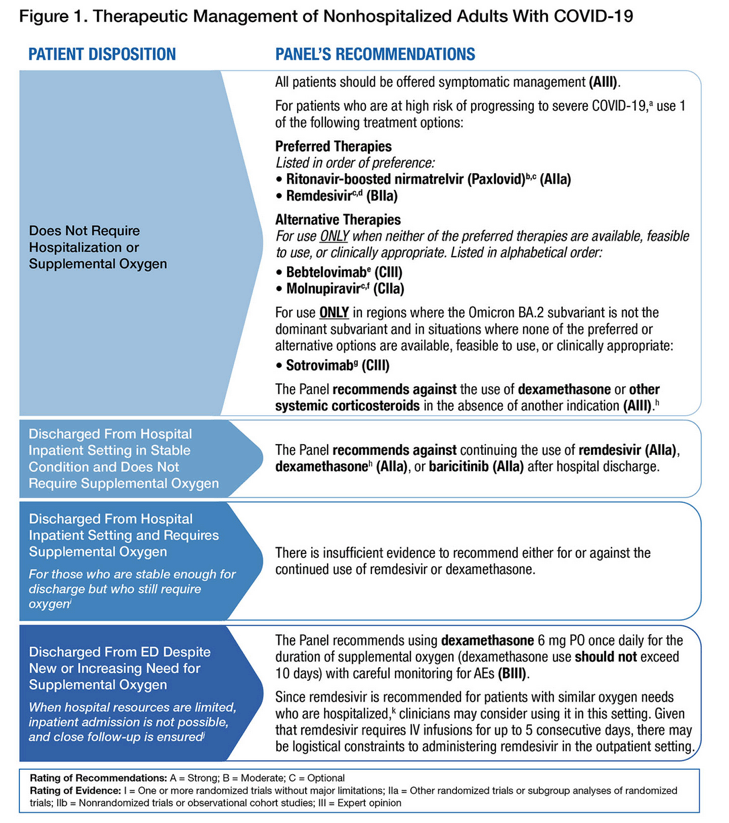
a For a list of risk factors, see the CDC webpage Underlying Medical Conditions Associated With Higher Risk for Severe COVID-19 and the Patient Prioritization for Treatment section below.
b Ritonavir-boosted nirmatrelvir has significant drug-drug interactions. Clinicians should carefully review a patient's concomitant medications and evaluate potential drug-drug interactions.
c If a patient requires hospitalization after starting treatment, the full treatment course can be completed at the health care provider's discretion.
d Administration of remdesivir requires 3 consecutive days of IV infusion.
e Bebtelovimab is active against all circulating Omicron subvariants, but there are no clinical efficacy data on using bebtelovimab to treat patients who are at high risk of progressing to severe COVID-19. Therefore, bebtelovimab should be used only when the preferred treatment options are not available, feasible to use, or clinically appropriate.
f Molnupiravir has lower efficacy than the preferred treatment options. Therefore, it should be used only when the preferred options are not available, feasible to use, or clinically appropriate.
g Sotrovimab is active against the Omicron BA.1 and BA.1.1 subvariants, but it has substantially decreased in vitro activity against the Omicron BA.2 subvariant. Visit the CDC COVID Data Tracker for information on the regional proportions of SARS-CoV-2 variants in the United States.
h There is currently a lack of safety and efficacy data on the use of this agent in outpatients with COVID-19; using systemic glucocorticoids in this setting may cause harm.
i These individuals should receive oximetry monitoring and close follow-up through telehealth, visiting nurse services, or in-person visits.
j Provide an advanced level of home care, including supplemental oxygen (whether patients are receiving oxygen for the first time or are increasing their baseline oxygen requirements), pulse oximetry, laboratory monitoring, and close follow-up through telehealth, visiting nurse services, or in-person visits.
k See Therapeutic Management of Hospitalized Adults With COVID-19.
Key: AE = adverse events; CDC = Centers for Disease Control and Prevention; ED = emergency department; IV = intravenous; the Panel = the COVID-19 Treatment Guidelines Panel; PO = orally
Patient Prioritization for Treatment
During surges in cases of SARS-CoV-2 infection, logistical or supply constraints may make it impossible to offer available therapeutics to all the nonhospitalized patients who are eligible to receive them. In these situations, the Panel recommends prioritizing the treatment of patients who are at the highest risk of clinical progression (see Prioritization of Anti-SARS-CoV-2 Therapies for the Treatment and Prevention of COVID-19 When There Are Logistical or Supply Constraints).
In Table A, the Panel has prioritized the risk groups for anti-SARS-CoV-2 therapy based on 4 key elements: age, vaccination status, immune status, and the presence of risk factors for clinical progression. The groups are listed in descending order of priority. For a list of risk factors, see the Centers for Disease Control and Prevention (CDC) website Underlying Medical Conditions Associated With Higher Risk for Severe COVID-19.
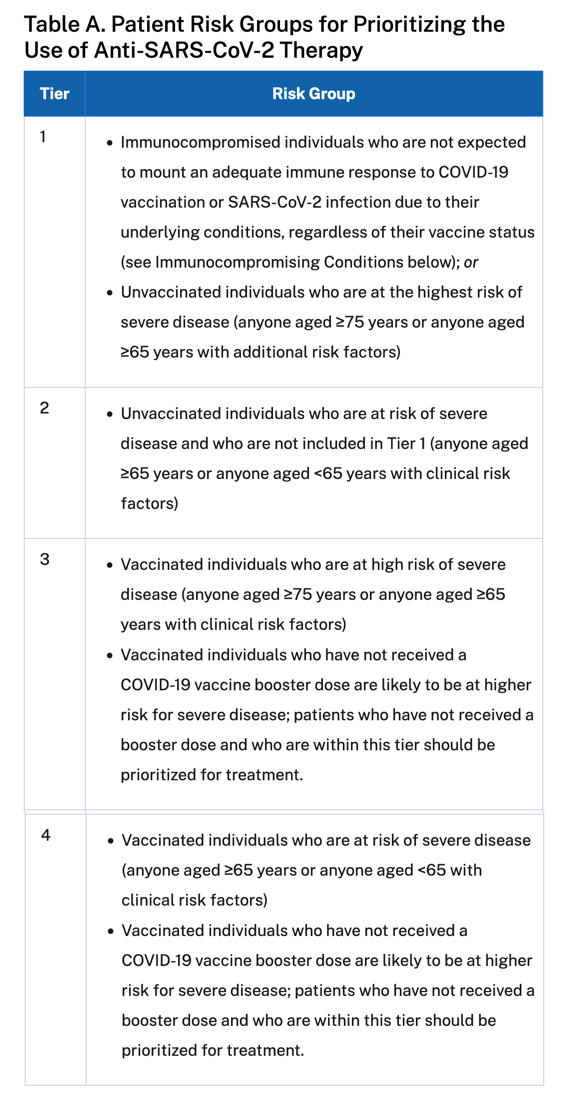
Immunocompromising Conditions
The CDC website COVID-19 Vaccines for Moderately or Severely Immunocompromised People provides a list of moderate and severe immunocompromising conditions.
If these anti-SARS-CoV-2 agents cannot be provided to all moderately to severely immunocompromised individuals because of logistical constraints or supply limitations, the Panel suggests prioritizing their use for those who are least likely to mount an adequate response to COVID-19 vaccination or SARS-CoV-2 infection and who are at risk for severe outcomes. This includes:
• Patients who are within 1 year of receiving B cell-depleting therapies (e.g., rituximab, ocrelizumab, ofatumumab, alemtuzumab)
• Patients who are receiving Bruton's tyrosine kinase inhibitors
• Chimeric antigen receptor T cell recipients
• Post-hematopoietic cell transplant recipients who have chronic graft versus host disease or who are taking immunosuppressive medications for another indication
• Patients with hematologic malignancies who are on active therapy
• Lung transplant recipients
• Patients who are within 1 year of receiving a solid organ transplant (other than a lung transplant)
• Solid organ transplant recipients with recent treatment for acute rejection with T cell- or B cell-depleting agents
• Patients with severe combined immunodeficiencies
• Patients with untreated HIV who have CD4 T lymphocyte cell counts <50 cells/mm3
If supplies are extremely limited, the Panel suggests prioritizing those who are more severely immunocompromised (based on the list above) and who have additional risk factors for severe disease.

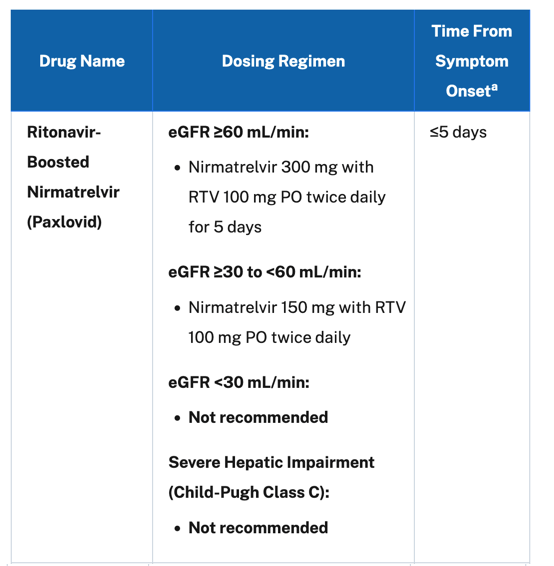
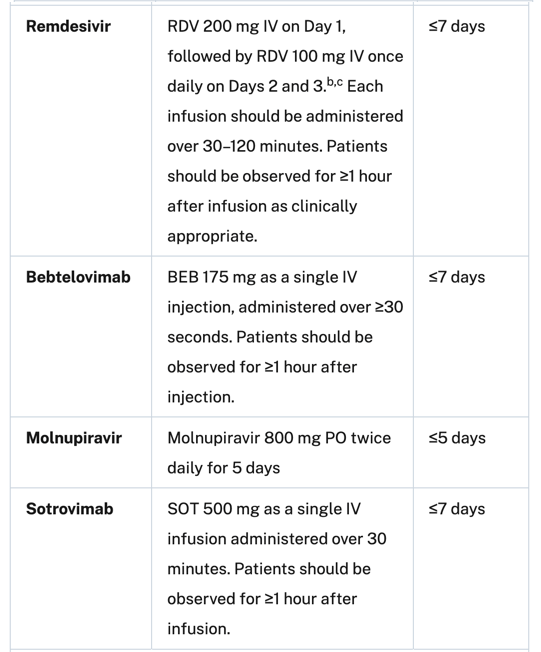
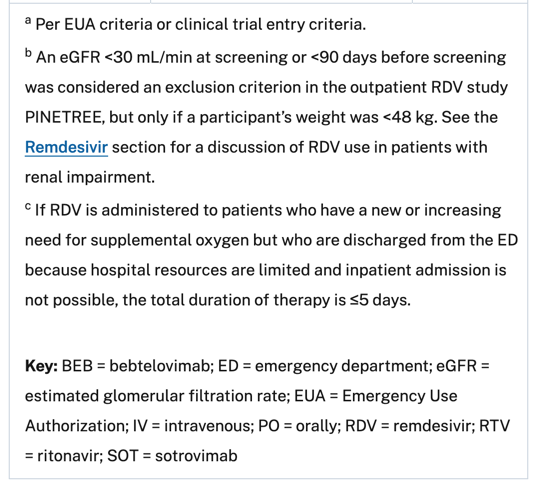
Symptom Management
Symptomatic treatment includes using over-the-counter antipyretics, analgesics, or antitussives for fever, headache, myalgias, and cough. Patients with dyspnea may benefit from resting in the prone position rather than the supine position.1 Health care providers should consider educating patients about breathing exercises, as severe breathlessness may cause anxiety.2 Patients should be advised to drink fluids regularly to avoid dehydration. Rest is recommended as needed during the acute phase of COVID-19, and ambulation and other forms of activity should be increased according to the patient's tolerance. Patients should be educated about the variability in time to symptom resolution and complete recovery.
Rationale for the Use of Specific Agents Listed in Figure 1
The Panel's recommendations for the therapeutics that are used to treat nonhospitalized patients with mild to moderate COVID-19 who are at risk of clinical progression are based on the results of clinical trials for the antiviral drugs (ritonavir-boosted nirmatrelvir, remdesivir, and molnupiravir) and on the results of clinical trials and/or laboratory assessments of the activity of the anti-SARS-CoV-2 monoclonal antibody (mAb) products (bebtelovimab and sotrovimab).
A number of factors may affect the selection of the best treatment option for a specific patient. These factors include the clinical efficacy of the treatment option against circulating variants, the availability of the treatment option, the feasibility of administering parenteral medications (i.e., remdesivir, bebtelovimab, sotrovimab), and the potential for significant drug-drug interactions (i.e., the interactions associated with using ritonavir-boosted nirmatrelvir).
The Panel recommends ritonavir-boosted nirmatrelvir or remdesivir as preferred therapy options because Phase 3 randomized placebo-controlled trials have reported high clinical efficacies for these agents in patients with COVID-19.3,4 The Panel favors the use of ritonavir-boosted nirmatrelvir in most high-risk, nonhospitalized patients with mild to moderate COVID-19. If ritonavir-boosted nirmatrelvir is not available or cannot be used because of drug interactions, the Panel recommends using remdesivir as the second option.
The Panel recommends bebtelovimab or molnupiravir as alternative therapy options. These drugs should ONLY be used when neither of the preferred treatment options are available, feasible to use, or clinically appropriate. The Food and Drug Administration (FDA) issued an Emergency Use Authorization (EUA) for bebtelovimab based on in vitro data that showed that bebtelovimab has activity against all circulating Omicron subvariants and clinical efficacy data from a small, Phase 2 clinical trial in individuals with mild to moderate COVID-19 who were at low risk of disease progression. However, there are no Phase 3 clinical trial data for bebtelovimab. Molnupiravir had lower clinical efficacy in Phase 3 clinical trials than the efficacies reported for the preferred treatment options.
Sotrovimab, which is active against the Omicron BA.1 and BA.1.1 subvariants, has substantially decreased in vitro activity against the Omicron BA.2 subvariant that is rapidly becoming the dominant subvariant in the United States.5-7 In the recently updated EUA, the FDA states that sotrovimab is not authorized for use in geographic regions where infection is likely to have been caused by a nonsusceptible SARS-CoV-2 variant.6 Distribution of sotrovimab was recently paused in some regions of the United States.8 As a result, the Panel recommends using sotrovimab only in regions where the Omicron BA.2 subvariant is not the dominant subvariant and only in cases where none of the preferred or alternative treatment options are available, feasible to use, or clinically appropriate.
There are currently no clinical trial data that directly compare the clinical efficacy of these 5 therapies, and there are no data on the use of combinations of antiviral agents and/or anti-SARS-CoV-2 mAbs for the treatment of COVID-19. The rationale for each of the Panel's recommendations is discussed below.
Ritonavir-Boosted Nirmatrelvir (Paxlovid)
Nirmatrelvir is an orally bioavailable protease inhibitor that is active against MPRO, a viral protease that plays an essential role in viral replication by cleaving the 2 viral polyproteins.9 It has demonstrated antiviral activity against all coronaviruses that are known to infect humans.10 Nirmatrelvir is packaged with ritonavir (as Paxlovid), a strong cytochrome P450 (CYP) 3A4 inhibitor and pharmacokinetic boosting agent. Ritonavir is required to increase nirmatrelvir concentrations to the target therapeutic ranges.
Recommendations
• The Panel recommends using nirmatrelvir 300 mg with ritonavir 100 mg (Paxlovid) orally (PO) twice daily for 5 days in those aged ≥12 years and weighing ≥40 kg; treatment should be initiated as soon as possible and within 5 days of symptom onset (AIIa).
• Ritonavir-boosted nirmatrelvir has significant and complex drug-drug interactions, primarily due to the ritonavir component of the combination.
• Before prescribing ritonavir-boosted nirmatrelvir, clinicians should carefully review the patient's concomitant medications, including over-the-counter medications and herbal supplements, to evaluate potential drug-drug interactions.
• The EUA fact sheet for ritonavir-boosted nirmatrelvir, the Liverpool COVID-19 Drug Interactions website, and guidance from the Ontario COVID-19 Science Advisory Table should be utilized to identify and manage drug-drug interactions. A quick reference guide is also provided in the Ritonavir-Boosted Nirmatrelvir (Paxlovid) section.
In the EPIC-HR trial, ritonavir-boosted nirmatrelvir reduced the risk of hospitalization or death by 88% compared to placebo in nonhospitalized adults with laboratory-confirmed SARS-CoV-2 infection.3,11 This efficacy is comparable to the efficacies reported in similar patient populations for sotrovimab (85% relative reduction)12 and remdesivir (87% relative reduction),4 and greater than the efficacy reported for molnupiravir in this setting (30% relative reduction).13
Ritonavir-boosted nirmatrelvir is expected to be active against all Omicron subvariants, although clinical efficacy data are lacking.14-16 Because ritonavir-boosted nirmatrelvir has the potential for significant drug-drug interactions with concomitant medications, this regimen may not be a safe choice for all patients (see Ritonavir-Boosted Nirmatrelvir [Paxlovid]). However, because ritonavir-boosted nirmatrelvir is the only highly effective oral antiviral available for the treatment of COVID-19, drug interactions that can be safely managed should not preclude the use of this medication.
The EPIC-HR trial excluded pregnant and lactating individuals. Ritonavir has been used extensively during pregnancy in people with HIV, which suggests that it has an acceptable safety profile during pregnancy. Based on the mechanisms of action for both nirmatrelvir and ritonavir and the available animal data, the Panel recommends ritonavir-boosted nirmatrelvir for pregnant patients because the potential benefits likely outweigh the risks.
Remdesivir
Remdesivir is currently approved by the FDA for use in hospitalized patients with COVID-19 and in nonhospitalized patients with mild to moderate COVID-19 who are at high risk of disease progression. Remdesivir has been studied in nonhospitalized patients with mild to moderate COVID-19 who were at high risk of progressing to severe disease. The PINETREE trial showed that 3 consecutive days of intravenous (IV) remdesivir resulted in an 87% relative reduction in the risk of hospitalization or death compared to placebo.4
Remdesivir is expected to be active against the Omicron VOC, although in vitro and in vivo data are currently limited.14 See the Remdesivir section for more details.
Recommendations
• The Panel recommends using remdesivir 200 mg IV on Day 1, followed by remdesivir 100 mg IV once daily on Days 2 and 3 in those aged ≥12 years and weighing ≥40 kg; treatment should be initiated as soon as possible and within 7 days of symptom onset (BIIa).
• Remdesivir should be administered in a setting where severe hypersensitivity reactions, such as anaphylaxis, can be managed. Patients should be monitored during the infusion and observed for at least 1 hour after infusion as clinically appropriate.
Because remdesivir requires IV infusions for 3 consecutive days, there may be logistical constraints to administering remdesivir in many settings. However, it is an option if ritonavir-boosted nirmatrelvir is not available.
The Panel recommends using remdesivir, dexamethasone, or both drugs together for hospitalized patients who require supplemental oxygen (see Therapeutic Management of Hospitalized Adults With COVID-19). When remdesivir is used in this setting, it is administered as a once-daily IV infusion for 5 days. There are rare instances when hospital resources are limited and admission to an inpatient unit is not possible for patients who need to initiate supplemental oxygen in the emergency department (ED) or who have increasing supplemental oxygen requirements. In these cases, patients may be discharged from the ED with close monitoring and are often prescribed dexamethasone for up to 10 days. Since remdesivir is often recommended for hospitalized patients with COVID-19 who have similar oxygen needs, clinicians can consider using it in this setting. However, it should be noted that the data on using remdesivir in this situation are limited, and administering IV infusions for up to 5 consecutive days can be difficult in the outpatient setting.
Bebtelovimab
Bebtelovimab is a recombinant neutralizing human mAb that binds to the spike protein of SARS-CoV-2. Based on in vitro data, bebtelovimab is expected to have activity against a broad range of SARS-CoV-2 variants, including the Omicron VOC and its BA.1, BA.1.1, and BA.2 subvariants.7,17 However, to date, the clinical trial data for bebtelovimab come from a single Phase 2 randomized placebo-controlled trial in patients with COVID-19 who were at low risk of progressing to severe disease. The trial showed no unexpected safety events, and patients who received bebtelovimab had more rapid viral decay than those who received the placebo.
Recommendations
• The Panel recommends using bebtelovimab 175 mg IV in those aged ≥12 years ONLY when ritonavir-boosted nirmatrelvir (Paxlovid) and remdesivir are not available, feasible to use, or clinically appropriate; treatment should be initiated as soon as possible and within 7 days of symptom onset (CIII).
• Bebtelovimab should be administered in a setting where severe hypersensitivity reactions, such as anaphylaxis, can be managed. Patients should be monitored during the infusion and observed for at least 1 hour after infusion.
Although there are insufficient data on hospitalization and mortality outcomes for patients with COVID-19 who were at high risk of disease progression and who received bebtelovimab, this agent has a mechanism of action that is similar to other anti-SARS-CoV-2 mAbs that have been shown to reduce rates of hospitalization or death among high-risk patients in Phase 3 trials. Therefore, the in vitro data and Phase 2 clinical data for bebtelovimab, coupled with the clinical efficacy data for other anti-SARS-CoV-2 mAbs, support the use of bebtelovimab in high-risk patients with COVID-19 when preferred treatment options are not available, feasible to use, or clinically appropriate.
Molnupiravir
Molnupiravir is the oral prodrug of beta-D-N4-hydroxycytidine (NHC), a ribonucleoside that has broad antiviral activity against RNA viruses. NHC uptake by viral RNA-dependent RNA-polymerases results in viral mutations and lethal mutagenesis.18,19
Molnupiravir has potent antiviral activity against SARS-CoV-2.18 As a mutagenic ribonucleoside antiviral agent, there is a theoretical risk that molnupiravir will be metabolized by the human host cell and incorporated into the host DNA, leading to mutations. Molnupiravir has been evaluated in 2 in vivo rodent mutagenicity assays. One study produced equivocal results; in the other study, there was no evidence for mutagenicity. The FDA concluded that, based on the available genotoxicity data and the 5-day duration of treatment, molnupiravir has a low risk for genotoxicity.20 In addition, there have been concerns about the potential effects of molnupiravir on SARS-CoV-2 mutation rates; the FDA is requiring the manufacturer to establish a process to monitor genomic databases for the emergence of SARS-CoV-2 variants.
Molnupiravir is expected to be active against the Omicron VOC, although in vitro and in vivo data are currently limited.14
Recommendation
• The Panel recommends using molnupiravir 800 mg PO twice daily for 5 days in those aged ≥18 years ONLY when ritonavir-boosted nirmatrelvir (Paxlovid) and remdesivir are not available, feasible to use, or clinically appropriate (CIIa).
In the MOVe-OUT trial, molnupiravir reduced the rate of hospitalization or death by 30% compared to placebo in nonhospitalized patients with COVID-19.13,20 Even though the different treatment options have not been directly compared in clinical trials, the Panel recommends using molnupiravir only when ritonavir-boosted nirmatrelvir and remdesivir are not available or cannot be used, because molnupiravir has lower efficacy than the other options (CIIa).
The FDA EUA states that molnupiravir is not recommended for use in pregnant patients due to concerns about the instances of fetal toxicity observed during animal studies. However, when other therapies are not available, pregnant people with COVID-19 who are at high risk of progressing to severe disease may reasonably choose molnupiravir therapy after being fully informed of the risks, particularly if they are beyond the time of embryogenesis (i.e., >10 weeks' gestation). The prescribing clinician should document that a discussion of the risks and benefits occurred and that the patient chose this therapy.
People who engage in sexual activity that may result in conception should use effective contraception during and following treatment with molnupiravir.
See this link for full article
https://www.covid19treatmentguidelines.nih.gov/management/clinical-management/nonhospitalized-adults--therapeutic-management/
|
|
| |
| |
|
|
|